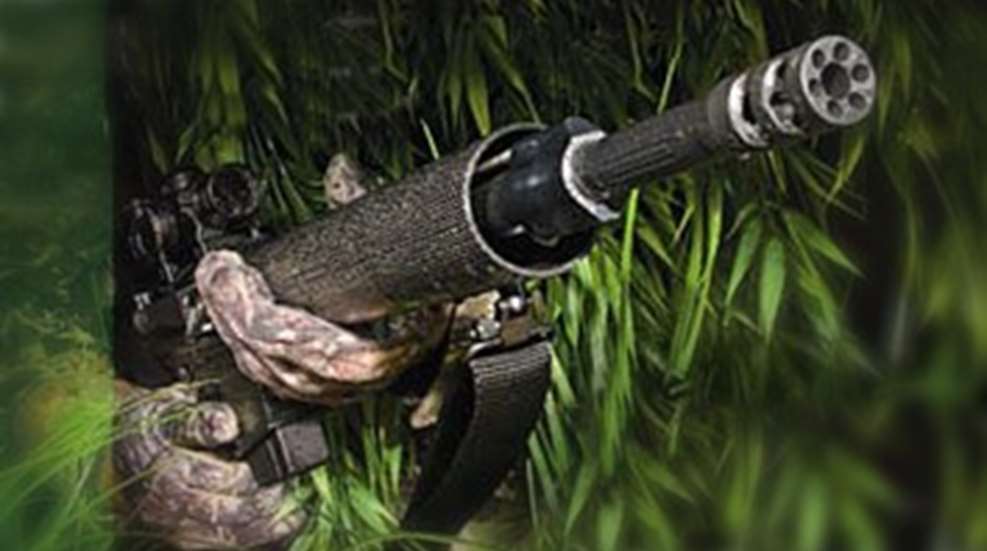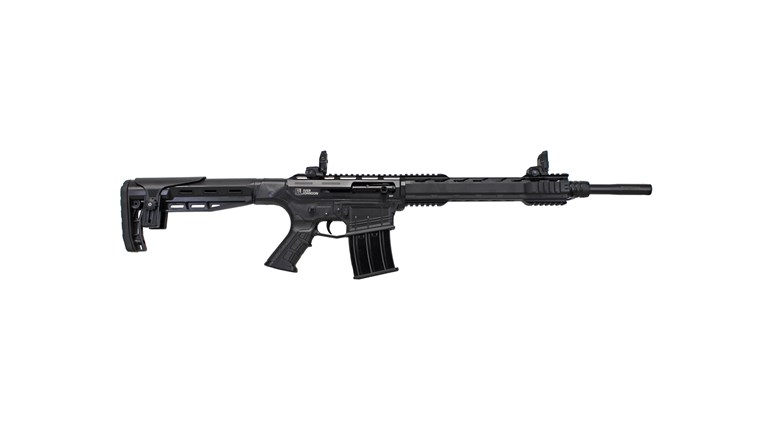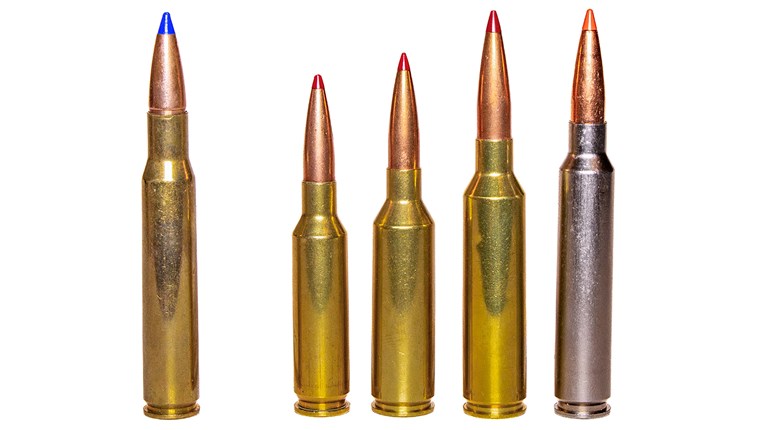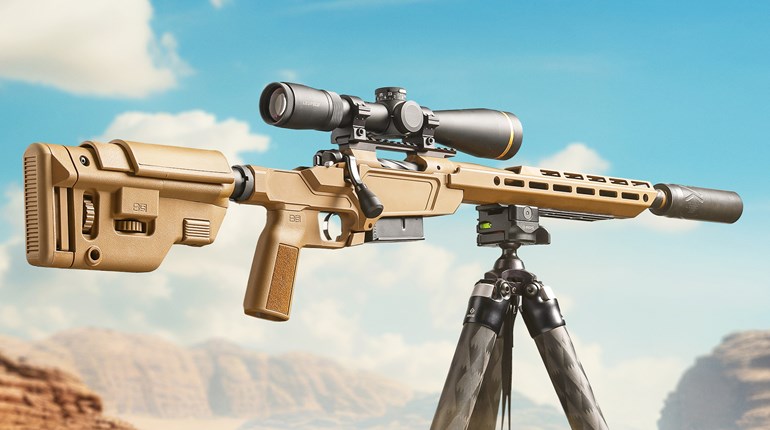
Hunters have benefited greatly from technology first employed and perfected on the battlefield. Go back to the 10th and 11th centuries when the Chinese and Muslims concocted gunpowder. Firearms may not even exist had it not been for civilizations of yesteryear using early forms of gunpowder to gain an advantage in war. Jump ahead about 1,000 years to the bolt-action rifle. The models we cling to in tree stands and carry over ridge tops owe much to the Mausers and Mosin-Nagants, Arisakas and Lee-Enfields that were fielded before in combat.
If you stop to think about it, the influence of military ordnance has caused nothing short of a revolution in the way we hunt. After all, most of us no longer chase animals over cliffs, stick them with spears or even shoot them with flintlocks to get our venison. As military firearms have developed, the guns we take hunting have followed—albeit with various modifications to suit the needs and wants of sportsmen.
That relationship continues today. Enter the AR-15, inextricably tied to the M16, which has served in the hands of U.S. troops for 40-some years. It was only a matter of time before the AR, like its bolt-action predecessors with military backgrounds, showed up at deer camp in some form.
DPMS is one black-rifle manufacturer that has embraced the AR's new role, building variations of the platform with features specifically intended for hunting. Although the company's long-barreled AR-15 variants chambered in .223 Rem. and .204 Ruger have found favor with varmint shooters, big-game hunters require cartridges with larger bullets and more power. DPMS turned to its LR-308 rifle, inspired by the AR-10 and chambered in .308 Win., to provide the basis for its new Panther Hunter series. The line includes four ARs, each chambered in a different cartridge belonging to the .308 Win. family, all designed with attributes to make them well suited for the field.
Lightweight Punch
The cartridges for which the rifles in the series are chambered will likely attract due attention from hunters and AR devotees alike. At least that was the case when I showed up at my local range toting samples of the four rifles in the line. It must have been a half-dozen times I explained not a one was for 5.56x45 mm or .223 Rem. Instead, I offered, hunters have their choice of .243 Win., .260 Rem., .308 Win. (of course) and .338 Federal. "That's the best thing that ever happened to those black rifles," said one shooter after I reviewed the lineup. "It's good to see them in real calibers."
Hunters who have never seriously considered the AR platform for big game may have similar feelings. To be sure, the .223 Rem will kill a deer or even an elk with the right shot, the right bullet and under the right circumstances, but it can never claim to be an ideal big-game cartridge. The .243 Win., .260 Rem. and .308 Win., however, have proven their effectiveness in the woods for decades. And even though the .338 Federal is the new member of the family, it, too, has become accepted for game up to and including elk.
To designate the model names of the new Panther ARs, DPMS keeps the "LR" prefix and combines it with the caliber of the rifle. The LR-243L is chambered in .243 Win., the LR-260L is in .260 Rem., and so on. The "L" that comes after each number signifies the rifle's lightweight configuration, another feature hunters will appreciate.
The rifles in the Panther Hunter series weigh 8 pounds without an optic, which is within ounces of most bolt guns. While the LR-308 has a 24-inch bull barrel and weighs more than 11 pounds, DPMS was able to shave some of that weight from the Hunter rifles by giving them 18-inch, light-contour barrels. Made from 416 stainless steel, the barrels on the Hunter ARs have six-groove, button rifling with a right-hand twist.
The twist rate varies by caliber: 1:10 inches for the LR-243L and LR-308L, 1:7 1⁄2 inches for the LR-260L and 1:9 inches for the LR-338L.
For protection against corrosion and scratches, the barrels have a black Teflon finish. Each is fitted with a compensator to help reduce recoil and muzzle flip. The LR-243L, LR-260L and LR-308L sport a Miculek compensator that follows the contour of the barrel and has three ports on each side. In contrast, the LR-338L's compensator adds a bit of diameter to the muzzle and has two pairs of large, recessed cutouts, as well as four smaller ports. Six more small ports encircle the face of the compensator. Along with a short run of fluting on the barrel, the LR-338L's compensator sets it apart from the rest of the Hunter rifles at a glance. Other than those differences, the four ARs have very similar appearances.
Cutting the barrels back to 18 inches saves some weight and makes the Hunter rifles easier to carry up a mountain, but it sacrifices velocity. During testing, most loads I chronographed produced muzzle velocities that were 150 to 200 fps lower than factory specifications. The loss of velocity was most noticeable in the LR-243L; bullets fired from it clocked 240 to almost 350 fps less than the ammunition manufacturers' claims. Velocity isn't the only factor to consider when hunting, however, and giving up some speed for a shorter, lighter rifle may be a fair tradeoff when the hike is long, steep or fraught with thick, gun-grabbing undergrowth. Besides, when loaded with a proper big-game bullet, each of these cartridges is capable of getting the job done on deer-sized game at normal hunting distances even if that bullet is traveling a couple hundred feet per second less than factory-published data.
Tough Hunters
Despite their big-game chamberings, the Hunter rifles remain true to the AR platform in both form and function. They rely on the direct gas-impingement system of operation and have standard-length gas tubes. This is important to hunters for three reasons. First, the semi-automatic action offers follow-up shots that require nothing more than the squeeze of the trigger upon recovery from recoil. In most states, it's the fastest, easiest legal way to send a second or third bullet on its way to a game animal. Next, the direct gas-impingement operating system helps reduce felt recoil, which means you'll more quickly recover from the first shot to reacquire that deer or antelope in the scope if necessary. Finally, the system is reliable enough for our troops to stake their lives on, so it should do just fine in your favorite woodlot.
The hefty steel bolt and bolt carrier in the Hunter rifles are phosphated and heat-treated to stand up to wear and tear. This is per mil spec, and again, components built to withstand the rigors of combat should have no problem handling what abuse you may dish out during a hunt. The upper receivers of the ARs in the lineup are extruded from 6066-T6 aluminum alloy used in the construction of aircraft and are hard-coat anodized. An inadvertent bang against an ill-tempered rock shouldn't cause much worry. The upper and lower receivers come from the factory with a black Teflon coating that won't alert game to your presence, although the LR-243L and LR-308L I received for testing were respectively decked out with a Mossy Oak Winter and a Next G-1 camo dip.
Optics have become an integral part of hunting, and the A3-style, flattop upper common among the Hunter rifles allows you to mount your favorite scope atop its Picatinny rail with ease. Iron sights are not provided on the rifles, so you'll need some glass before taking them to the field. I recommend mounting a scope in high or extra-high rings, as the high, straight comb of the Hunter ARs' A2-style buttstock can make it difficult to get your eye in line with an optic that sits low on the receiver. Although a scope mounted in extra-high rings may appear to tower over the rifle, I think in practice most hunters will find it almost second nature to acquire the crosshair with this arrangement. Also consider that a scope mounted too low on the receiver will interfere with gaining a grasp on the charging handle.
All of the rifles in the Hunter series are set up for right-handed shooters, and the ejection port with dustcover is on the right side. The forward assist plunger is contained within a housing that serves as the brass deflector. With a large, flat surface, the brass deflector had no problem catching ejected cases and flipping them away from the rifle, so I think left-handed shooters needn't worry about hot brass coming in contact with their facial features.
Surrounding the barrel and gas tube on the Hunter rifles in a lightweight, tubular fore-end made of carbon fiber. It measures 121⁄2 inches long and is free-floating along its entire length. A long, free-floating tube offers several advantages to the hunter. Because the tube is smooth and devoid of corners, your off hand can easily slide along its surface when shouldering the rifle or changing shooting positions. That's not to say it is slippery; the weave of the carbon fiber provides a subtle texture that helps maintain tactile control. Since the fore-end doesn't come into direct contact with the barrel, you don't have to worry about changes in tension on the tube affecting point of impact. The fore-end measures about two inches in diameter, and its shape fits neatly into the "V" formed by shooting sticks or between the ears of a sandbag. Another function of the tube is to protect your hand from a hot barrel. Bolted to the fore-end is a stud for attaching a bipod or a sling. The low-profile gas block just forward of the fore-end sits below the top edge of the tube for a clean look.
Milled from a solid billet of 6061-T6 aluminum, the lower receivers of the Hunter series rifles have the same hard-coat anodizing and black Teflon finish as the uppers. The safety switch and magazine-release button are in the standard AR locations. Taking into account the angle at which the pistol grip presents the shooting hand in relation to the lower receiver, the safety lever on the Hunter rifles—and all ARs for that matter—is just as easy for me to engage than the sliding or wing-style safeties on most bolt actions, if not more so. It is not, however, as quiet to operate. The hollow, exposed metal upper and lower receivers of AR-style rifles act as a sounding board to magnify the click.
Each Hunter rifle comes with two magazines: one with a four-round capacity, and the other with a 19-round capacity. For hunting, I much prefer the shorter of the two, and in some states, the lower-capacity magazine may be mandated by game laws. ARs simply feel different than bolt actions or lever guns, and having a long magazine hanging out the belly of the rifle only helps to magnify that difference. The four-round magazine extends just 3⁄4 inch below the bottom edge of the magazine well and makes for a more compact package. It is also less likely to hang up on brush or the edge of a tree stand or a shooting rail.
Realizing that hunters crave a clean, crisp trigger pull on their rifles, DPMS gives each Hunter AR a JP Enterprises adjustable trigger group. The JP trigger can be adjusted for pull weight, engagement and overtravel. It's a good thing that the triggers in the Hunter rifles are adjustable, as the pull weights from the factory measured around 6 pounds, or about twice what I prefer for hunting. Luckily, some time spent with the proper tools, spring set and instructions would remedy that situation.
The pistol grip on the LR-243L, LR-260L and LR-308L are the Command Arms Accessories G27 model, although the pre-production LR-260L I received had a Hogue rubber overmolded grip, while the LR-243L and LR-308L sported a standard A2-style grip. The G27 is a textured, rubber grip with finger grooves and palm swells, and should be appreciated by hunters on cold, blustery days in the field. The LR-338L comes with a Hogue rubber overmolded grip that helps pad the hand against the recoil produced by the stouter cartridge.
The A2-style buttstock on the Hunter series rifles is made of black Zytel. Perhaps a carryover from AR tradition, the buttstock ends in a checkered, black polymer buttplate that features a trapdoor. The usefulness of the trapdoor is questionable, seeing as how the the buttstock is skeletonized to reduce weight. I suppose a cleaning rod kit would still fit in the buttstock and may stay there during a hunt, but I wouldn't want to take the chance of losing it out the side. Nor would I want to deal with it rattling around when I move the rifle. I'd rather see the Hunter rifles equipped with a solid rubber buttpad to help cut down on recoil. I'll clean my rifle when I get back to camp.
Big-Game Accuracy
The Hunter series rifles have enough features to appeal to the guy or gal who wants to use an AR for big game, but do they have the accuracy? I spent several days at the range shooting groups from the bench, offhand and in a sitting position to find out. The short answer is yes, but you'll want to try more than one load or brand of ammunition before taking off on a hunt. In other words, the Hunter ARs probably aren't much different when it comes to accuracy than the rifle you are currently using for big game.
After mounting a scope on each rifle, I fired five, five-shot groups at 100 yards with three brands of ammunition to complete the formal accuracy test. Like most rifles, each of the Hunter ARs showed a preference for a particular load.
With a Burris Fullfield II 6.5-20x50 mm mounted on the LR-243L, the overall group average for three brands of ammunition was 1.21 inches. The LR-243L was the best-shooting rifle of the bunch, turning in a five, five-shot group average of 1.1 inches with the Winchester Supreme 95-grain Ballistic Silvertip load.
I put a Nikon Monarch 2.5-10x42 mm on the LR260-L and got an overall group average of 1.36 inches. This doesn't tell the whole story, though, for the Federal Premium Vital-Shok 140-grain Sierra GameKing load produced a five, five-shot group average of 1.16 inches, including one group that measured right at 1 inch. Two more groups would have been close to or better than that mark had it not been for fliers in each case that added 1⁄8 inch or more to the measurement.
The LR308-L liked the Fiocchi Extrema 180-grain Hornady SST load the best. I topped this rifle with a Bushnell Elite 4200 2.5-10x40 mm and shot an average of 1.29 inches for five, five-shot groups with the Fiocchi ammunition. Hornady's 150-grain Interlock BTSP load wasn't far behind at 1.39 inches.
The Federal Premium Vital-Shok 185-grain Barnes Triple-Shock X-Bullet load gave the top performance in the LR-338L. With a Bushnell Elite 4200 1.25-4x24 mm aboard, the rifle turned in a five, five-shot group average of 1.4 inches.
Overall, accuracy from the Hunter series rifles was on par with most bolt actions and lever guns intended for hunting when they are shot with factory hunting loads. I do not doubt that some time at the loading bench would result in better accuracy. A longer or heavier barrel may improve accuracy as well, but it would come at the cost of lightweight maneuverability.
Shooting the Hunter rifles offhand was a completely different experience than working a bolt or lever gun in an unsupported position. As you would expect, follow-up shots came much more quickly with the ARs, a product of not having to manually cycle the action and the lower felt recoil. The straight design of the A2-style buttstock and the compensators on the rifles' muzzles also played a part. Muzzle flip was a much less than with the two bolt actions and the lever gun I shot for comparison. The Hunter rifles recoiled straight back into my shoulder, and I lost little time getting back on target after each shot.
New Fun
So where do the Hunter ARs fit into big-game hunting as we know it? Any place where a hunter wants to try something a little different than the traditional. (Check your game laws first, as some states prohibit hunting big game with semi-automatic rifles.)
The LR338-L would be a particularly good choice for up-close hunting in thick brush or timber. I think it would make an excellent gun for black bears. On the other hand, the LR-243L would be right at home on the prairie, when the next shot you take could be at a coyote or an antelope. The LR-260L and LR-308L fall somewhere in between. The fun part is deciding what you want to hunt with an AR, then choosing the appropriate caliber for the job. The DPMS Hunter series gives you plenty of options.





































